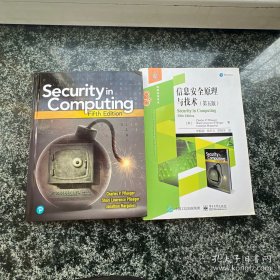
信息安全原理与技术(第五版)(英文版. 中文评注) 英文原版
英文原版,精装锁线,基本全新
¥ 799 九五品
仅1件
黑龙江牡丹江
认证卖家担保交易快速发货售后保障
作者[美]Charles(C. P. 弗莱格)、Shari Lawrence Pfleeger 著;李毅超 译
出版社电子工业出版社
出版时间2016-08
版次5
装帧平装
上书时间2024-12-03
- 最新上架
商品详情
- 品相描述:九五品
图书标准信息
- 作者 [美]Charles(C. P. 弗莱格)、Shari Lawrence Pfleeger 著;李毅超 译
- 出版社 电子工业出版社
- 出版时间 2016-08
- 版次 5
- ISBN 9787121288593
- 定价 99.00元
- 装帧 平装
- 开本 16开
- 纸张 胶版纸
- 页数 824页
- 字数 1500千字
- 正文语种 英语
- 丛书 经典译丛·网络空间安全
- 【内容简介】
-
本书是信息安全经典著作,共12章,系统描述了信息安全的各个方面,实现了计算机安全领域的完整、实时、全面的覆盖,内容包括用户、软件、设备、操作系统、网络等,反映了迅速变化的攻击、防范和计算环境,介绍了*新的*佳实践,用户认证,防止恶意代码的执行,加密技术的使用,隐私的保护,防火墙的实现和入侵检测技术的实施等。第五版对当前信息安全领域的新课题都有涉及,加入了Web交互、云计算、大数据、物联网和网络战等方面的安全技术,以及前沿课题的研究。
- 【作者简介】
-
李毅超,电子科技大学数学科学学院教授,IEEE会士,四川省信息系统安全等级保护评审特聘专家,电子科技大学信息安全领域组专家。主要从事计算机网络及应用技术、网络与信息系统安全技术、网络与嵌入式电子信息化技术等方面研究工作。目前逐步将研究领域拓展到航空航天电子信息技术。作为课题负责人或骨干研究人员已完成国家自然科学基金、国家863计划等项目大小30余项。
Charles P. Pfleeger,计算机和通信安全领域的国际著名专家。他最初是美国田纳西大学的教授,离开那里后加入了计算机安全研究和咨询公司Trusted Information Systems和Arca Systems(后来去了Exodus Communications和Cable and Wireless)。在Trusted Information Systems时他任欧洲运营主管和高级顾问。在Cable and Wireless时任研究主管和首席安全官成员。他还是IEEE计算机协会安全和隐私技术委员会的主席。
Shari Lawrence Pfleeger,知名软件工程师和计算机安全研究员,最近成为兰德公司(RAND)的高级计算机科学家和信息基础设施保护研究院的研究主管。她目前是IEEE Security & Privacy杂志的总编辑。 Jonathan Margulies Qmulos首席技术官,网络安全咨询专家。获得美国康奈尔大学计算机科学硕士学位后,Margulies在桑迪亚国家实验室(Sandia National Lab)工作了9年,研究和开发针对国家安全和关键基础设施系统中高级持续性威胁的保护方案。后来他加入NIST国家网络安全卓越中心,在那里,他与各种关键基础设施公司一起搭建了工业标准安全架构。业余时间,他在IEEE Security & Privacy杂志负责“Building Security In”版块的编辑工作。
- 【目录】
-
Chapter 1 Introduction
概论001
1.1 What is Computer Security
什么是计算机安全?002
1.2 Threats
威胁006
1.3 Harm
危害021
1.4 Vulnerabilities
脆弱点028
1.5 Controls
控制028
1.6 Conclusion
总结031
1.7 What’s Next
下一步是什么?032
1.8 Exercises
习题034
Chapter 2 Toolbox: Authentication, Access Control, and Cryptography
工具箱:鉴别、访问控制与加密036
2.1 Authentication
鉴别038
2.2 Access Control
访问控制072
2.3 Cryptography
密码编码学086
2.4 Exercises
练习127
Chapter 3 Programs and Programming
程序和编程130
3.1 Unintentional (Nonmalicious) Programming Oversights
无意的(非恶意的)程序漏洞132
3.2 Malicious Code―Malware
恶意代码――恶意软件165
3.3 Countermeasures
对策195
3.4 Conclusion
总结228
3.5 Exercises
练习228
Chapter 4 Operating Systems
操作系统230
4.1 Security in Operating Systems
操作系统的安全性230
4.2 Security in the Design of Operating Systems
安全操作系统的设计258
4.3 Rootkit
Rootkit279
4.4 Conclusion
总结288
4.5 Exercises
习题289
Chapter 5 Databases
数据库291
5.1 Introduction to Databases
数据库简介292
5.2 Security Requirements of Databases
数据库的安全需求297
5.3 Reliability and Integrity
可靠性和完整性303
5.4 Database Disclosure
数据库泄露308
5.5 Data Mining and Big Data
数据挖掘和大数据325
5.6 Conclusion
总结339
5.7 Exercises
习题339
Chapter 6 Networks
网络341
6.1 Network Concepts
网络的概念342
6.2 Threats to Network Communications
网络通信的威胁354
6.3 Wireless Network Security
无线网络安全374
6.4 Denial of Service
拒绝服务396
6.5 Distributed Denial-of-Service
分布式拒绝服务421
6.6 Cryptography in Network Security
网络安全中的密码学432
6.7 Firewalls
防火墙451
6.8 Intrusion Detection and Prevention Systems
入侵检测和防御系统474
6.9 Network Management
网络管理489
6.10 Conclusion
总结496
6.11 Exercises
习题496
Chapter 7 Management and Incidents
安全管理和事件501
7.1 Security Planning
安全计划501
7.2 Business Continuity Planning
业务持续计划512
7.3 Handling Incidents
事件处理516
7.4 Risk Analysis
风险分析522
7.5 Dealing with Disaster
处理灾难540
7.6 Conclusion
总结553
7.7 Exercises
练习554
Chapter 8 Details of Cryptography
密码学精讲555
8.1 Cryptology
密码学556
8.2 Symmetric Encryption Algorithms
对称加密算法566
8.3 Asymmetric Encryption with RSA
RSA非对称加密582
8.4 Message Digests
消息摘要586
8.5 Digital Signatures
数字签名589
8.6 Quantum Cryptography
量子密码学594
8.7 Conclusion
总结598
Chapter 9 Privacy
计算机中的隐私600
9.1 Privacy Concepts
隐私的概念601
9.2 Privacy Principles and Policies
隐私的原理和政策610
9.3 Authentication and Privacy
鉴别和隐私624
9.4 Data Mining
数据挖掘630
9.5 Privacy on the Web
网站上的隐私633
9.6 Email Security
电子邮件安全性646
9.7 Privacy Impacts of Emerging Technologies
对新技术的影响650
9.8 Where the Field is Headed
领域前沿658
9.9 Conclusion
总结659
9.10 Exercises
习题659
Chapter 10 The Web―User Side
Web和用户661
10.1 Browser Attacks
针对浏览器的攻击663
10.2 Web Attacks Targeting Users
针对用户的Web攻击674
10.3 Obtaining User or Website Data
获取用户或网站的数据689
10.4 Email Attacks
电子邮件攻击696
10.5 Conclusion
总结706
10.6 Exercises
习题707
Chapter 11 Cloud Computing
云计算708
11.1 Cloud Computing Concepts
云计算的概念708
11.2 Moving to the Cloud
迁移到云端710
11.3 Cloud Security Tools and Techniques
云安全工具与技术717
11.4 Cloud Identity Management
云认证管理725
11.5 Securing IaaS
加固IaaS736
11.6 Conclusion
总结740
11.7 Exercises
习题741
Chapter 12 Emerging Topics
新兴问题743
12.1 The Internet of Things
物联网744
12.2 Economics
网络安全经济学751
12.3 Electronic Voting
电子投票764
12.4 Cyber Warfare
网络战争771
12.5 Conclusion
总结780
Bibliography
参考文献781
点击展开
点击收起
— 没有更多了 —





















以下为对购买帮助不大的评价